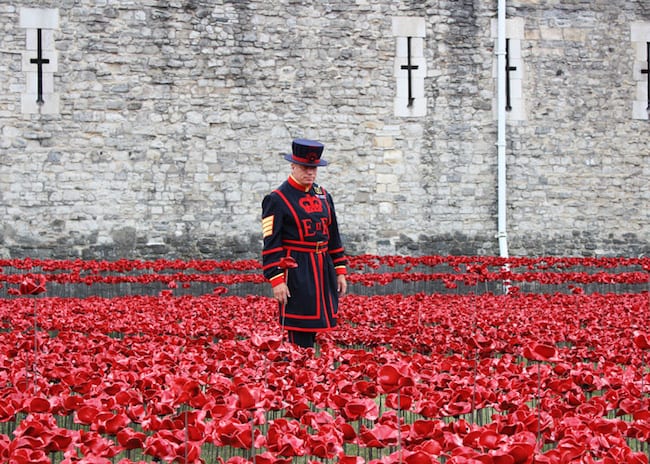It’s difficult to truly comprehend the horror of the first World War. Beyond our awareness of it being eclipsed by its sequel, there’s a point after which the numbers of dead and injured become almost meaningless, too enormous to grasp effectively.
Millions of people, many of whom had idealized, almost romantic ideas about warfare were thrown into a conflict that no country was prepared for. Using outdated battlefield tactics from before Europe’s industrial age, these men were put up against diabolical, coldly-effective killing machines that had never been used before. Artillery shells, machine guns and caustic gasses chewed through human lives at an average rate of more than 7,000 per day. The hellish suffering of this conflict is often reduced to math, and we need to rely on people like amateur historian Dan Carlin to recontextualize the numbers into a narrative that, 100 years later, is still immediate and profoundly disturbing.

The public art installation Blood Swept Lands and Seas of Red sits right at this crossroad of statistics and storytelling. Using more than 800,000 ceramic poppies and a poem written by an unknown soldier who was likely swallowed by the conflict, theater designer Tom Piper and ceramic artist Paul Cummins are creating a piece at the Tower of London that gives legions of dead men their humanity back. A team of volunteers is assembling the enormous memorial, one ceramic flower for each British and Colonial military fatality. The Mirror states that the work will be completed by November 11th, Armistice Day. The flowers will then be sold, raising money for charities which benefit British servicepeople.

The ceramic portions of the flowers are attached to metal stems. They flow out of a window on the Tower and wash over the lawn. This is obviously a wave of blood and I’m thankful for the horror of it. Many war memorials, especially those supported by the State, seem to intentionally draw our attention away from the meat-and-viscera reality of those they purport to honor. In this way these memorials deify the conflict rather than pay respect to the soldiers, otherwise peaceful men and women who had their lives violently snuffed out in wars they had no hand in initiating. Kurt Vonnegut would’ve loved this.

Below is the text of the poem which served as inspiration for the installation. Void of nationalism, the anonymous soldier slogs through another day in the trenches knowing— not fearing– that he will die. In his final moments he wishes only to memorialize his friends, kiss his children goodnight and make the pain stop. His flower is somewhere in that wave pictured above.
The Blood Swept Lands and Seas of Red
By Anon – Unknown SoldierThe blood swept lands and seas of red,
Where angels dare to tread.
As I put my hand to reach,
As God cried a tear of pain as the angels fell,
Again and again.As the tears of mine fell to the ground
To sleep with the flowers of red
As any be deadMy children see and work through fields of my
Own with corn and wheat,
Blessed by love so far from pain of my resting
Fields so far from my love.It be time to put my hand up and end this pain
Of living hell, to see the people around me
Fall someone angel as the mist falls around
And the rain so thick with black thunder I hear
Over the clouds, to sleep forever and kiss
The flower of my people gone before time
To sleep and cry no moreI put my hand up and see the land of red,
This is my time to go over,
I may not come back
So sleep, kiss the boys for me
Bill Rodgers is a Contributing Editor at CFile.
Above images: Tom Piper and Paul Cummins, Bloodswept Lands and Seas of Red, 2014, porcelain and wire
Any thoughts about this post? Share yours in the comment box below.



Tom Piper and Paul Cummins, Bloodswept Lands and Seas of Red, 2014, porcelain and wire

“War! What is it good for? Absolutely nothing!”
So powerful a poem. So pitiable a sight. So profligate a war.
Will we ever learn?
Wow I was moved to tears this installation is such a moving tribute to the horror of ww1 that can never be fully understood.